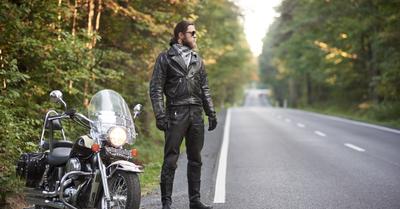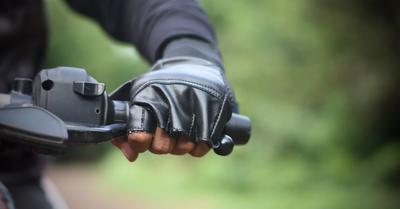The Production of the Honda Valkyrie
In 1997 Honda produced a bike to complement its Gold Wing series called the Valkyrie to compete with the big twin cruisers of the time. It was sold in the US market alongside the Gold Wing as the GL 1500C, and in other countries as the F6C (Flat Six Custom). Like a Goldwing, it had impressive power with 100 bhp and a max torque of 87 ft.lb with a top speed of 115 mph doing the quarter mile in 12 seconds.
In 2003, the same year that its production came to an end, the limited edition model Valkyrie Rune was released with a massive 1,832cc liquid-cooled flat-six engine bumping up the bhp to 117 and the torque to 123 lb.ft at 4,000 rpm.
When production ended in 2004, ten years later, the new model Honda Valkyrie was reintroduced as a redesign of Honda’s GL1800 Gold Wing using the same 1832cc but coming in 150 lbs lighter for more power.
This new Honda Valkyrie had an increased trail and rake, front and rear suspension upgrades for the lighter weight, a 50/50 weight distribution, and a power-to-weight ratio that put it into the muscle bike class. This tourer model had an ideal riding position much like a sports bike with a seat height of 29”. This seat height was ideal for many riders that seek stability. In Japan, it actually was introduced with a reverse gear. After two years, Honda finally closed the doors to Valkyrie manufacturing in the US market for good.
The Reasons for the Durability of the Honda Valkyrie
The Honda Valkyrie Flat-Six Engine
The Valkyrie has a horizontally opposed flat-six 1,520 cc (93 cu in) liquid-cooled, engine similar to the Honda Gold Wing model and in juxtaposition with a V-twin normally found in its competition’s big-engined cruiser motorcycles. To increase power and torque, the Valkyrie engine’s camshaft has 28 mm individual carburetors for each of the six cylinders.
Power-To-Weight Ratio of the Valkyrie Engine
The power-to-weight ratio means that this flat-six motor is generating 100 bhp and over 100 lb.ft. of torque with much of it free above idle on a stripped-down 800 lb frame. This increases the lifespan of the motor and leads to incredibly high mileage as it is barely working even while cruising.
Imagine a 1995 Honda Civic VX Hatchback engine built for a one-ton, 2,178 lb car. This engine’s power is 92 horsepower with 97 max torque and it is compressed onto a motorcycle that weighs less than 800 lbs. The same can be said for a 1995 Ford Escort and many other cars. The Valkyrie has power to spare and the motor is never taxed unlike other motorcycles.
Liquid-cooled Engine of the Valkyrie Engine
Longevity is about temperature, and the lack of stress on the motor allows it to run cooler and last longer than the average engine.
The underutilized Valkyrie engine operates at lower temperatures than its competition because the motor is not generating as much heat due to reduced combustion and friction. Lower temperatures can reduce the likelihood of overheating and other temperature-related issues that can damage the engine and shorten its lifespan.
Because the Valkyrie engine design creates less stress, there is less carbon buildup in the engine's components. Carbon buildup can occur due to incomplete combustion and can clog up the engine's components, reducing efficiency, and causing damage over time. With reduced carbon buildup, the motor can operate more efficiently, reducing the likelihood of damage, and extending its lifespan.
The Balance of the Valkyrie Engine
The flat-six motor is unique and called a pancake design. It has three cylinders on the back of each side. This motor was manufactured from the beginning for smooth balance and the elimination of vibration.
Vibration causes wear and tear on any machine’s parts. Other bikes vibrate dynamically creating friction, oscillation, and metal exhaustion which damages the engine. The balanced nature of the flat-six removes this issue for an incredibly smooth ride and a much longer life for the Valkyrie than other cruisers.
Directly Driven Alternator
The Honda Valkyrie’s alternator is directly driven by the engine unlike the power cruiser that indirectly mounts them with chains or belts to relieve stress from the motor. The Valkyrie’s alternator produces enough amps for upgrades and any of its electrical needs creating reliable energy output and longer life.
Wet Clutches
Wet clutches are sealed in oil which requires less maintenance and less replacement than dry clutches which do not have the advantage of oil lubricating the metal parts.
Wet clutches offer several advantages over dry clutches. One advantage is that the oil in the clutch system helps to dissipate heat, which can be generated during heavy use, such as stop-and-go traffic or aggressive riding. This can help prevent the clutch plates from overheating and warping, which can lead to premature wear and tear and reduce the life of the clutch and the bike.
Additionally, the oil in a wet clutch system can help to reduce friction between the clutch plates, which can also help preserve the life of the clutch and the bike. The oil helps to keep the plates from rubbing against each other and wearing down, which can reduce the clutch's effectiveness and cause damage to other components in the transmission.
Shaft Drive
While a power cruiser may opt for chain drives, the Valkyrie has a sealed shaft drive that requires no maintenance other than routinely lubricating the bearings during a rear tire change and every once in a while checking the level of lubricant in the gear case.
The Reasons for the Discontinuation of the Honda Valkyrie
The Weaknesses of the Honda Valkyrie Motorcycle
O-rings on the Spline Can Wear Down
In looking through the reviews and Valkyrie forums, criticism of this bike is rare, but one minor complaint that is often mentioned is that the o-rings of the spline wear down quickly if not maintained.
The spline on a Honda Valkyrie motorcycle is located at the front end of the driveshaft that connects the transmission to the rear wheel. The driveshaft is covered by a rubber boot, which can be removed to access the spline.
Every 10,000 miles or so, remove the rubber boot covering the spline and clean the spline with a degreaser to remove any dirt or debris that may have accumulated on it. You can use a soft-bristled brush to help remove any stubborn grime.
Once the spline is clean, apply a thin layer of high-quality molybdenum disulfide (Moly) grease to the spline. You can use a brush to spread it evenly and then replace the rubber boot.
Hydrostatic Lock
Although rare, hydrostatic lock or hydro-lock is another complaint and can occur when water or other fluids enter the combustion chamber and prevent the piston from completing its cycle. When this happens, the piston cannot compress the fluid, which can cause the motor to stop suddenly and potentially cause serious damage to the engine.
If water or other fluids enter the engine’s internal chambers through the air intake, exhaust system, or other openings such as riding through deep water or heavy rain, or if the bike is left outside in the rain without proper protection, it is important to avoid attempting to start the engine as this can cause further damage. Instead, the bike should be towed to a mechanic or repair shop for assessment and repairs. Depending on the extent of the damage, repairs may involve replacing damaged engine components, such as the piston or connecting rod.
Difficulty in Keeping Clean
The Honda Valkyrie has hundreds of thousands of hard-to-reach crevices in the chrome that are difficult to clean. While routine maintenance is fairly simple on this bike, cleaning it can be time consuming. It takes quite a bit of time and patience to keep the lavish chrome and all the nooks and crannies clean of this beautifully made motorcycle.
The Lack of Vibration in the Honda Valkyrie Motorcycle
This complaint may be antithetical to logic, but is the most significant weakness of the Honda Valkyrie motorcycle which in the end led to its demise. The reason it is out of production is customer expectations. When a rider purchases a big cruising bike, they are doing it for more than just getting from point A to point B. They could just purchase a Honda Civic. A motorcycle is always about feel.
The Valkyrie did not meet the rider’s expectations in this department. Some say the Valkyrie engine was too perfect. They manufactured it for performance, durability, and efficiency…but not necessarily with the customer in mind. The average cruiser wants to feel the bike shack, rattle, and roll. Like a Harley Davidson, they expect to hear a roar that will wake up the neighbors and then vibrate their bones as they jolt through the gears. It’s about atmosphere and vibe, and unlike a Harley, the Valkyrie was just too smooth. It didn’t pass the vibe check.
Perhaps it reminded people of riding a car without doors and a roof, but it wasn’t what they were looking for. Of course, there is still a remnant of die-hard Valkyrie enthusiasts that are fanatics about this beautiful, powerful, fantastic bike. They point out the longevity, power, and cool look of this monster despite the lack of a normal cruiser feel.
But thanks to this lack of vibration, with proper maintenance and oil changes the average Honda Valkyrie owner will enjoy years and years and mile after mile of motorcycle longevity. Some forums have contributors that boast of riding 400,000 miles on their Valkyrie. Most have the original bike without engine replacement and going strong since 1997. If you maintain the Honda Valkyrie well and average about 5,000 miles a year, you could ride up to 60 years on the bike to reach that 300,000-mile mark.














